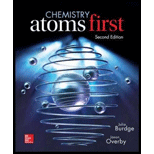
Chemistry: Atoms First
2nd Edition
ISBN: 9780073511184
Author: Julia Burdge, Jason Overby Professor
Publisher: McGraw-Hill Education
expand_more
expand_more
format_list_bulleted
Question
Chapter 24, Problem 24.47QP
Interpretation Introduction
Interpretation:
- The structures of poly(1-butyne) and poly(1-butene), showing three or more repeating units has to be drawn
- The difference and similarity between them has to be given
- Which of these will conduct electricity has to be mentioned.
Concept Introduction:
Polymers are macromolecules which are formed a by number of repeating units called monomers. Based on the techniques involved in preparation of polymers, it can be classified asaddition polymer and condensation polymer.- Addition polymers are formed by a number of additions of unsaturated monomers one after the other.
Condensation polymers are formed when two compounds condense with each other by giving out small molecules (water or methanol) as by-products. - When an organic compound acts as monomer and undergoes
polymerization reaction, the product formed is called as organic polymers. Organic polymers which bears a monomer with triple bond in it will conduct electricity.
To Give:
- The structures of poly(1-butyne) and poly(1-butene), showing three or more repeating units
- The difference and similarity between poly(1-butyne) and poly(1-butene)
- Which of these will conduct electricity
Expert Solution & Answer
Want to see the full answer?
Check out a sample textbook solution
Chapter 24 Solutions
Chemistry: Atoms First
Ch. 24.1 - Prob. 24.1WECh. 24.1 - Prob. 1PPACh. 24.1 - Prob. 1PPBCh. 24.1 - Prob. 1PPCCh. 24.1 - Prob. 24.2WECh. 24.1 - Prob. 2PPACh. 24.1 - Prob. 2PPBCh. 24.1 - Prob. 2PPCCh. 24.1 - Prob. 24.1.1SRCh. 24.1 - Prob. 24.1.2SR
Ch. 24.3 - Would the following molecule make a good liquid...Ch. 24.3 - Prob. 3PPACh. 24.3 - Prob. 3PPBCh. 24.3 - Prob. 3PPCCh. 24.3 - Prob. 24.3.1SRCh. 24.3 - Prob. 24.3.2SRCh. 24.6 - Prob. 24.4WECh. 24.6 - Prob. 4PPACh. 24.6 - Prob. 4PPBCh. 24.6 - Prob. 4PPCCh. 24.6 - Prob. 24.6.1SRCh. 24 - Bakelite, the first commercially produced polymer,...Ch. 24 - Prob. 24.2QPCh. 24 - Prob. 24.3QPCh. 24 - Prob. 24.4QPCh. 24 - Prob. 24.5QPCh. 24 - Prob. 24.6QPCh. 24 - Prob. 24.7QPCh. 24 - Describe two natural types of composite materials...Ch. 24 - Prob. 24.9QPCh. 24 - Amorphous silica (SiO2) can be formed in uniform...Ch. 24 - Prob. 24.11QPCh. 24 - Prob. 24.12QPCh. 24 - Prob. 24.13QPCh. 24 - Prob. 24.14QPCh. 24 - Prob. 24.15QPCh. 24 - Prob. 24.16QPCh. 24 - Prob. 24.17QPCh. 24 - Prob. 24.18QPCh. 24 - Prob. 24.19QPCh. 24 - Prob. 24.20QPCh. 24 - Prob. 24.21QPCh. 24 - How does an STM measure the peak and valley...Ch. 24 - Prob. 24.23QPCh. 24 - Prob. 24.24QPCh. 24 - Prob. 24.25QPCh. 24 - Prob. 24.26QPCh. 24 - Prob. 24.27QPCh. 24 - Prob. 24.28QPCh. 24 - Prob. 24.29QPCh. 24 - Prob. 24.30QPCh. 24 - Prob. 24.31QPCh. 24 - Prob. 24.32QPCh. 24 - Prob. 24.33QPCh. 24 - Prob. 24.34QPCh. 24 - Prob. 24.35QPCh. 24 - Prob. 24.36QPCh. 24 - Prob. 24.37QPCh. 24 - Draw representations of block copolymers and graft...Ch. 24 - Prob. 24.39QPCh. 24 - Prob. 24.40QPCh. 24 - Prob. 24.41QPCh. 24 - Prob. 24.42QPCh. 24 - Prob. 24.43QPCh. 24 - Prob. 24.44QPCh. 24 - Prob. 24.45QPCh. 24 - Prob. 24.46QPCh. 24 - Prob. 24.47QPCh. 24 - Prob. 24.48QP
Knowledge Booster
Recommended textbooks for you
 World of Chemistry, 3rd editionChemistryISBN:9781133109655Author:Steven S. Zumdahl, Susan L. Zumdahl, Donald J. DeCostePublisher:Brooks / Cole / Cengage Learning
World of Chemistry, 3rd editionChemistryISBN:9781133109655Author:Steven S. Zumdahl, Susan L. Zumdahl, Donald J. DeCostePublisher:Brooks / Cole / Cengage Learning Chemistry: The Molecular ScienceChemistryISBN:9781285199047Author:John W. Moore, Conrad L. StanitskiPublisher:Cengage Learning
Chemistry: The Molecular ScienceChemistryISBN:9781285199047Author:John W. Moore, Conrad L. StanitskiPublisher:Cengage Learning Chemistry: Principles and ReactionsChemistryISBN:9781305079373Author:William L. Masterton, Cecile N. HurleyPublisher:Cengage Learning
Chemistry: Principles and ReactionsChemistryISBN:9781305079373Author:William L. Masterton, Cecile N. HurleyPublisher:Cengage Learning Chemistry: Principles and PracticeChemistryISBN:9780534420123Author:Daniel L. Reger, Scott R. Goode, David W. Ball, Edward MercerPublisher:Cengage Learning
Chemistry: Principles and PracticeChemistryISBN:9780534420123Author:Daniel L. Reger, Scott R. Goode, David W. Ball, Edward MercerPublisher:Cengage Learning Organic ChemistryChemistryISBN:9781305580350Author:William H. Brown, Brent L. Iverson, Eric Anslyn, Christopher S. FootePublisher:Cengage Learning
Organic ChemistryChemistryISBN:9781305580350Author:William H. Brown, Brent L. Iverson, Eric Anslyn, Christopher S. FootePublisher:Cengage Learning Introductory Chemistry: An Active Learning Approa...ChemistryISBN:9781305079250Author:Mark S. Cracolice, Ed PetersPublisher:Cengage Learning
Introductory Chemistry: An Active Learning Approa...ChemistryISBN:9781305079250Author:Mark S. Cracolice, Ed PetersPublisher:Cengage Learning

World of Chemistry, 3rd edition
Chemistry
ISBN:9781133109655
Author:Steven S. Zumdahl, Susan L. Zumdahl, Donald J. DeCoste
Publisher:Brooks / Cole / Cengage Learning

Chemistry: The Molecular Science
Chemistry
ISBN:9781285199047
Author:John W. Moore, Conrad L. Stanitski
Publisher:Cengage Learning

Chemistry: Principles and Reactions
Chemistry
ISBN:9781305079373
Author:William L. Masterton, Cecile N. Hurley
Publisher:Cengage Learning

Chemistry: Principles and Practice
Chemistry
ISBN:9780534420123
Author:Daniel L. Reger, Scott R. Goode, David W. Ball, Edward Mercer
Publisher:Cengage Learning

Organic Chemistry
Chemistry
ISBN:9781305580350
Author:William H. Brown, Brent L. Iverson, Eric Anslyn, Christopher S. Foote
Publisher:Cengage Learning

Introductory Chemistry: An Active Learning Approa...
Chemistry
ISBN:9781305079250
Author:Mark S. Cracolice, Ed Peters
Publisher:Cengage Learning